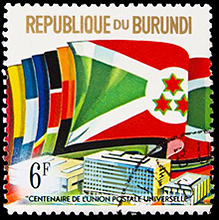| Home A B C D E F G H I J K L M N O P Q R S T U V W X Y Z |
|
Home |
Where Is Burundi and What
|
|
 A stamp printed in Burundi showing flags circa 1975. |
The densely populated east African state of Burundi consists of high plateaus rising from the shores of Lake Tanganyika in the southwest. Burundi, officially the Republic of Burundi, is a landlocked country in the Great Lakes region bordered by Rwanda to the north, Tanzania to the east and south, and the Democratic Republic of the Congo to the west. Its size is just under 28,000 kmē with an estimated population of almost 8,700,000. Its capital is Bujumbura.
The Twa, Tutsi, and Hutu peoples have occupied Burundi since the country's formation five centuries ago. Burundi was ruled as a kingdom by the Tutsi for over two hundred years. However, at the beginning of the twentieth century, Germany and Belgium occupied the region, and Burundi and Rwanda became a European colony known as Ruanda-Urundi.
Political unrest occurred throughout the region because of social differences between the Tutsi and Hutu, provoking civil war in Burundi throughout the middle twentieth century. Presently, Burundi is governed as a presidential representative democratic republic. Sixty-two percent of Burundians are Roman Catholic, eight to ten percent are Muslims and the rest follow indigenous beliefs and other Christian denominations.
Burundi is one of the ten poorest countries in the world. It has the lowest per capita GDP of any nation in the world. Burundi has a low gross domestic product largely due to civil wars, corruption, poor access to education, and the effects of HIV/AIDS. Burundi is densely populated, with substantial emigration. It has a tropical climate and depends on subsistence farming. Cobalt and copper are among Burundi's natural resources. Some of Burundi's main exports include coffee and sugar.
|
Glossary References Links Contact
|